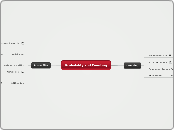arabera Sarah Schuelke 12 years ago
727
Probability and Counting Chart

arabera Sarah Schuelke 12 years ago
727

Honelako gehiago
P(A or B) = P(A) + P(B) - P(both)
P(A or B) = P(A) + P(B)
"At least one" = one or more
-complement of getting at least one particular event means that you get NO occurance of that event.
P(A) and P(A -)
No
Dependent
Dependent: if A & B are not independent
-selection without replacement
P(A & B) = P(A) * P(B| A)
P(B|A) = probability of event B occuring after event A
Yes
Independent
Independent: if occurance of events A and B does not affect the probability of the occurance of the other.
- with replacement
-5% rule
P(A) * P(B)
P(E) = # of ways E occurs/ total # of outcomes
n! = # of different permutations of 'n' different items when all 'n' of them are selected.
Combinations -are arrangements in which different sequences of the same items are not counted separately.
nCr = n! / ((n-r)!r!) = # of different combinations (order doesn't matter) when 'n' different items are available but only 'n' of them are selected without replacement.
Permutations are arrangements in which different sequences of the same items are counted separately
n!n1!n2! ...nk! = # of different permutations when 'n' items are available and all 'n' are selected without replacement, but some items are identical to others.